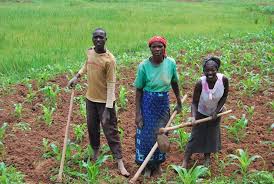Farmers in Nyagatare and Kayonza districts have called upon investors to support them in acquiring agri-machinery, like tractors, so that they can increase the outcomes of farming in the area.
The call follows the Ministry of Agriculture’s approval of 70 per cent of the districts’ farmlands for crop farming, instead of being exclusively reserved for pastoralism, with a goal to increase agricultural productivity and reduce the risks of food scarcity in the country.
Speaking to The New Times, the farmers welcomed the development, but noted that they have limited resources for making the most of the opportunity presented to them.
Here, they cited challenges including reliance on manual labour to prepare their land. This, according to them, delays planting, for example.
“I aim to grow maize on a larger portion of my 20 hectares in Kayonza District’s Murundi sector, but without tractors, it might take me weeks or months to finish the project. It is time-consuming and, as you know, agriculture requires weather planning,” said Aaron Mugemangango, a ranch owner in Murundi.
He plans to use profits from selling maize to invest in better livestock management practices and infrastructure, maximising the crop residues as feed for his livestock.
The Eastern Province comprises more than 10,000 farmlands, with thousands of hectares that will need to be cultivated for the first time after the government’s approval to cultivate the lands.
The cultivation of the proposed land has the potential to bring numerous benefits to the region, including reducing the risk of food scarcity and boosting local economies by creating employment opportunities, despite a challenging start, according to farmers.
Here, they cited challenges including reliance on manual labour to prepare their land. This, according to them, delays planting, for example.
“I aim to grow maize on a larger portion of my 20 hectares in Kayonza District’s Murundi sector, but without tractors, it might take me weeks or months to finish the project. It is time-consuming and, as you know, agriculture requires weather planning,” said Aaron Mugemangango, a ranch owner in Murundi.
He plans to use profits from selling maize to invest in better livestock management practices and infrastructure, maximising the crop residues as feed for his livestock.
The Eastern Province comprises more than 10,000 farmlands, with thousands of hectares that will need to be cultivated for the first time after the government’s approval to cultivate the lands.
The cultivation of the proposed land has the potential to bring numerous benefits to the region, including reducing the risk of food scarcity and boosting local economies by creating employment opportunities, despite a challenging start, according to farmers.
“It is challenging to dig huge pieces of land using manual labour; we need tractors; the available are already booked; we have realised that the demand has exceeded the available tractors,” said another farmer, Ruzindana Rusagara, a resident in Karangazi sector in Nyagatare District.
While acquiring digging equipment may seem costly or challenging, there are potential solutions and strategies that can be explored, according to officials from the Rwanda Agriculture Board.
“In 2018, RAB granted accreditation to private companies to distribute services, including agricultural mechanisation equipment. The government also exempted value-added tax (VAT) on agricultural equipment, including tractors. RAB, along with partner projects like the Sustainable Agricultural Intensification and Food Security Project (SAIP) and Rwanda Dairy Development Project (RDDP), gives farmers subsidies on rental or purchased equipment. There are 39 companies where farmers can access agricultural mechanisation equipment,” Olivier Sangwa, the in-charge of agricultural mechanisation at the Rwanda Agriculture Board, said.
Rwanda’s mechanisation programme began in the fiscal year 2009/2010 to encourage the use of farm machinery in various farming activities for rural farmers, with a strategic aim of increasing agricultural mechanisation from 27 per cent to 50 per cent by 2024.
Currently, according to CG (Rtd) Emmanuel K Gasana, the Eastern Province Governor, more than 61 tractors have been procured and farmers have been linked with investors to facilitate the ongoing cultivation activities aimed at bridging food productivity.
The Governor said it is expected that there will be an increase of 30 per cent of the previously arable land that will be cultivated in season A, 2023-2024.
Maize, soybeans, and beans will be the primary crops to be planted in the newly added hectares for cultivation.










